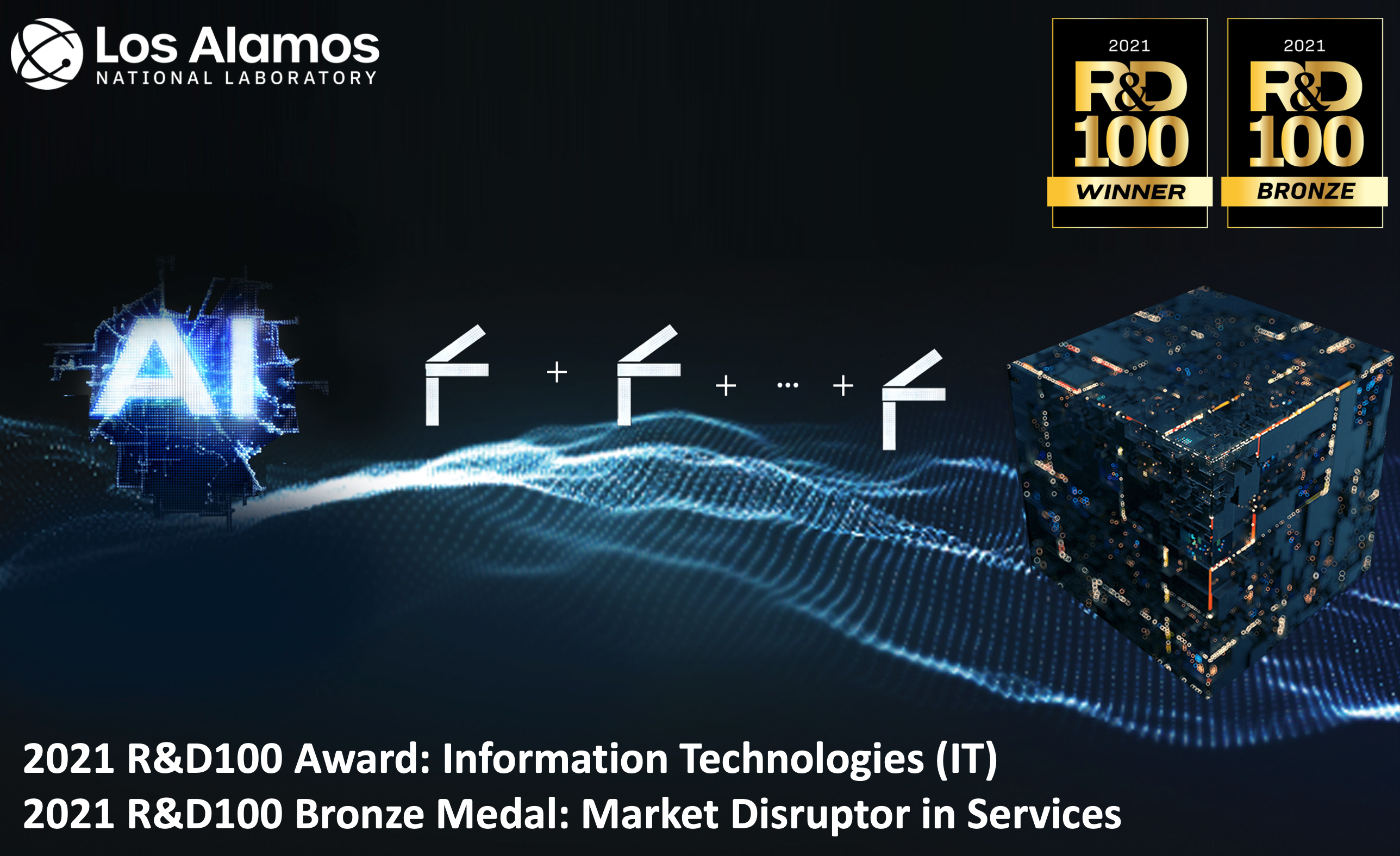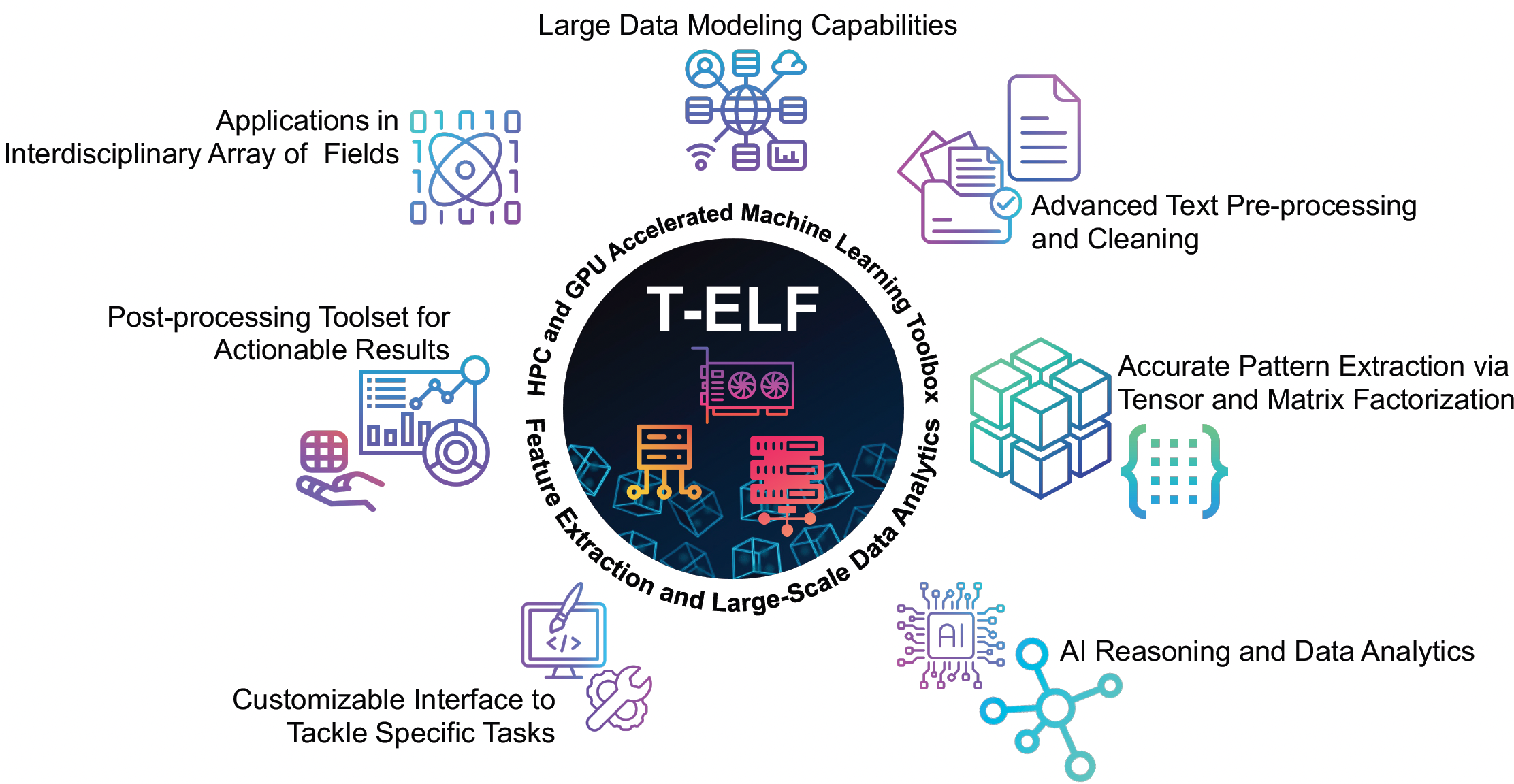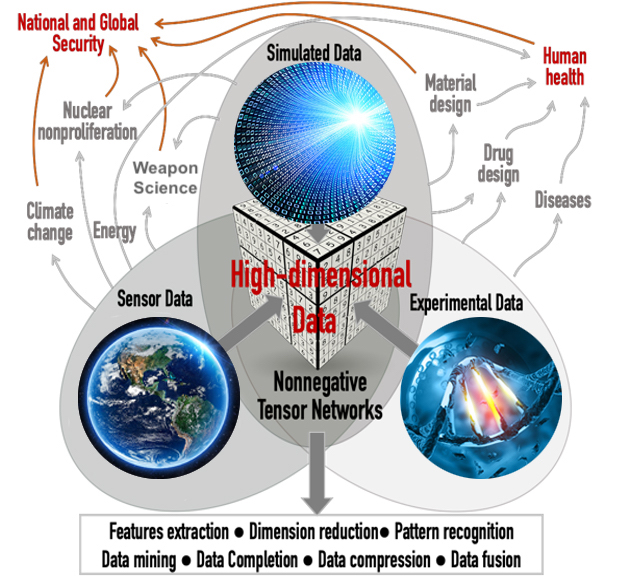T-ELF is one of the machine learning software packages developed as part of the R&D 100 winning SmartTensors AI project at Los Alamos National Laboratory (LANL). T-ELF presents an array of customizable software solutions crafted for analysis of datasets. Acting as a comprehensive toolbox, T-ELF specializes in data pre-processing, extraction of latent features, and structuring results to facilitate informed decision-making. Leveraging high-performance computing and cutting-edge GPU architectures, our toolbox is optimized for analyzing large datasets from diverse set of problems.
Central to T-ELF's core capabilities lie non-negative matrix and tensor factorization solutions for discovering multi-faceted hidden details in data, featuring automated model determination facilitating the estimation of latent factors or rank. This pivotal functionality ensures precise data modeling and the extraction of concealed patterns. Additionally, our software suite incorporates cutting-edge modules for both pre-processing and post-processing of data, tailored for diverse tasks including text mining, Natural Language Processing, and robust tools for matrix and tensor analysis and construction.
T-ELF's adaptability spans across a multitude of disciplines, positioning it as a robust AI and data analytics solution. Its proven efficacy extends across various fields such as Large-scale Text Mining, High Performance Computing, Computer Security, Applied Mathematics, Dynamic Networks and Ranking, Biology, Material Science, Medicine, Chemistry, Data Compression, Climate Studies, Relational Databases, Data Privacy, Economy, and Agriculture.
Option 1: Install via PIP
conda create --name TELF python=3.11.5
source activate TELF # or <conda activate TELF>
pip install git+https://github.com/lanl/T-ELF.gitOption 2: Install from Source
git clone https://github.com/lanl/T-ELF.git
cd T-ELF
conda create --name TELF python=3.11.5
source activate TELF # or <conda activate TELF>
pip install -e . # or <python setup.py install>Option 3: Install via Conda
git clone https://github.com/lanl/T-ELF.git
cd T-ELF
conda env create --file environment_gpu.yml # use <conda env create --file environment_cpu.yml> for CPU only
conda activate TELF_conda
conda develop .python -m spacy download en_core_web_lg
python -m spacy download en_core_web_trf
python -m nltk.downloader wordnet omw-1.4conda install -c conda-forge cupymodule load <openmpi> # On a HPC Node
pip install mpi4py # or <conda install -c conda-forge mpi4py> depending on the systemJupyter Setup Tutorial for using the examples (Link)
On some Linux devices, based on how CUDA was configured, you may get an error when using a GPU. Install cudatoolkit to resolve the error:
conda install cudatoolkit
conda install cudnnPlease see our 📃 Publications for the capabilities
| Method | Dense | Sparse | GPU | CPU | Multiprocessing | HPC | Description | Example | Release Status |
|---|---|---|---|---|---|---|---|---|---|
| NMFk | ✔️ | ✔️ | ✔️ | ✔️ | ✔️ | ✔️ | NMF with Automatic Model Determination | Link | ✅ |
| Custom NMFk | ✔️ | ✔️ | ✔️ | ✔️ | ✔️ | ✔️ | Use Custom NMF Functions with NMFk | Link | ✅ |
| TriNMFk | ✔️ | ✔️ | ✔️ | ✔️ | ✔️ | NMF with Automatic Model Determination for Clusters and Patterns | Link | ✅ | |
| RESCALk | ✔️ | ✔️ | ✔️ | ✔️ | ✔️ | ✔️ | RESCAL with Automatic Model Determination | Link | ✅ |
| RNMFk | ✔️ | ✔️ | ✔️ | ✔️ | ✔️ | ✔️ | Recommender NMFk | Link | ✅ |
| SymNMFk | ✔️ | ✔️ | ✔️ | ✔️ | ✔️ | NMFk with Symmetric Clustering | Link | ✅ | |
| WNMFk | ✔️ | ✔️ | ✔️ | ✔️ | ✔️ | NMFk with weighting - used for recommendation system | Link | ✅ | |
| HNMFk | ✔️ | ✔️ | ✔️ | ✔️ | ✔️ | Hierarchical NMFk | Link | ✅ | |
| BNMFk | Boolean NMFk | 🔜 | |||||||
| SPLIT NMFk | Joint NMFk factorization of multiple data via SPLIT | 🔜 | |||||||
| SPLIT Transfer Classifier | Supervised transfer learning method via SPLIT and NMFk | 🔜 | |||||||
| CP-ALS | Alternating least squares algorithm for canonical polyadic decomposition | 🔜 | |||||||
| CP-APR | Alternating Poisson regression algorithm for canonical polyadic decomposition | 🔜 | |||||||
| NTDS_FAPG | Non-negative Tucker Tensor Decomposition | 🔜 |
| Method | Multiprocessing | HPC | Description | Example | Release Status |
|---|---|---|---|---|---|
| Vulture | ✔️ | ✔️ | Advanced text processing tool for cleaning and NLP | Link | ✅ |
| Beaver | ✔️ | ✔️ | Fast matrix and tensor building tool for text mining | Link | ✅ |
| iPenguin | Online Semantic Scholar information retrieval tool | 🔜 | |||
| Orca | Duplicate author detector for text mining and information retrival | 🔜 | |||
| Method | Description | Example | Release Status |
|---|---|---|---|
| Peacock | Data visualization and generation of actionable statistics | 🔜 | |
| Wolf | Graph centrality and ranking tool | 🔜 | |
| Fox | Report generation tool for text data | 🔜 | |
| SeaLion | Generic report generation tool | 🔜 |
| Method | Description | Example | Release Status |
|---|---|---|---|
| Cheetah | Fast search by keywords and phrases | Link | ✅ |
| Bunny | Dataset generation tool for documents and their citations/references | 🔜 | |
| Termite | Knowladge graph building tool | 🔜 |
If you use T-ELF please cite.
APA:
Eren, M., Solovyev, N., Barron, R., Bhattarai, M., Truong, D., Boureima, I., Skau, E., Rasmussen, K., & Alexandrov, B. (2023). Tensor Extraction of Latent Features (T-ELF) (Version 0.0.14) [Computer software]. https://doi.org/10.5281/zenodo.10257897BibTeX:
@software{TELF,
author = {Eren, Maksim and Solovyev, Nick and Barron, Ryan and Bhattarai, Manish and Truong, Duc and Boureima, Ismael and Skau, Erik and Rasmussen, Kim and Alexandrov, Boian},
month = oct,
title = {{Tensor Extraction of Latent Features (T-ELF)}},
url = {https://github.com/lanl/T-ELF},
doi = {10.5281/zenodo.10257897},
year = {2023}
}- Maksim Ekin Eren: Advanced Research in Cyber Systems, Los Alamos National Laboratory (Website)
- Nicholas Solovyev: Theoretical Division, Los Alamos National Laboratory
- Ryan Barron: Theoretical Division, Los Alamos National Laboratory
- Manish Bhattarai: Theoretical Division, Los Alamos National Laboratory
- Duc Truong: Theoretical Division, Los Alamos National Laboratory
- Ismael Boureima: Theoretical Division, Los Alamos National Laboratory
- Erik Skau: Computer, Computational, and Statistical Sciences Division, Los Alamos National Laboratory
- Kim Rasmussen: Theoretical Division, Los Alamos National Laboratory
- Boian S. Alexandrov: Theoretical Division, Los Alamos National Laboratory
Boian ALEXANDROV, o. S. F., New Mexico, Maksim Ekin EREN, of Sante Fe, New Mexico, Manish BHATTARAI, of Albuquerque, New Mexico, Kim Orskov RASMUSSEN of Sante Fe, New Mexico, and Charles K. NICHOLAS, of Columbia, Maryland, (“Assignor”) DATA IDENTIFICATION AND CLASSIFICATION METHOD, APPARATUS, AND SYSTEM. No. 63/472,188. Triad National Security, LLC. (June 9, 2023).
BS. Alexandrov, LB. Alexandrov, and VG. Stanev et al. 2020. Source identification by non-negative matrix factorization combined with semi-supervised clustering. US Patent S10,776,718 (2020).
© 2022. Triad National Security, LLC. All rights reserved. This program was produced under U.S. Government contract 89233218CNA000001 for Los Alamos National Laboratory (LANL), which is operated by Triad National Security, LLC for the U.S. Department of Energy/National Nuclear Security Administration. All rights in the program are reserved by Triad National Security, LLC, and the U.S. Department of Energy/National Nuclear Security Administration. The Government is granted for itself and others acting on its behalf a nonexclusive, paid-up, irrevocable worldwide license in this material to reproduce, prepare derivative works, distribute copies to the public, perform publicly and display publicly, and to permit others to do so.
LANL C Number: C22048
This program is open source under the BSD-3 License. Redistribution and use in source and binary forms, with or without modification, are permitted provided that the following conditions are met:
-
Redistributions of source code must retain the above copyright notice, this list of conditions and the following disclaimer.
-
Redistributions in binary form must reproduce the above copyright notice, this list of conditions and the following disclaimer in the documentation and/or other materials provided with the distribution.
-
Neither the name of the copyright holder nor the names of its contributors may be used to endorse or promote products derived from this software without specific prior written permission.
THIS SOFTWARE IS PROVIDED BY THE COPYRIGHT HOLDERS AND CONTRIBUTORS "AS IS" AND ANY EXPRESS OR IMPLIED WARRANTIES, INCLUDING, BUT NOT LIMITED TO, THE IMPLIED WARRANTIES OF MERCHANTABILITY AND FITNESS FOR A PARTICULAR PURPOSE ARE DISCLAIMED. IN NO EVENT SHALL THE COPYRIGHT HOLDER OR CONTRIBUTORS BE LIABLE FOR ANY DIRECT, INDIRECT, INCIDENTAL, SPECIAL, EXEMPLARY, OR CONSEQUENTIAL DAMAGES (INCLUDING, BUT NOT LIMITED TO, PROCUREMENT OF SUBSTITUTE GOODS OR SERVICES; LOSS OF USE, DATA, OR PROFITS; OR BUSINESS INTERRUPTION) HOWEVER CAUSED AND ON ANY THEORY OF LIABILITY, WHETHER IN CONTRACT, STRICT LIABILITY, OR TORT (INCLUDING NEGLIGENCE OR OTHERWISE) ARISING IN ANY WAY OUT OF THE USE OF THIS SOFTWARE, EVEN IF ADVISED OF THE POSSIBILITY OF SUCH DAMAGE.
Developer test suites are located under tests/ directory. Tests can be ran from this folder using python -m pytest *.





